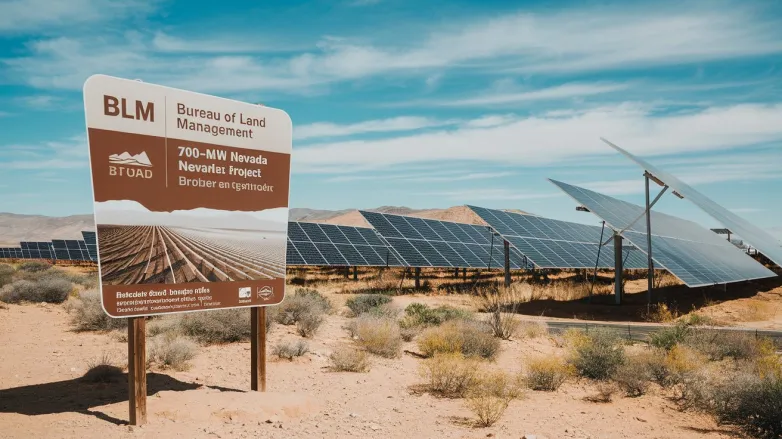BLM Seeks Feedback on 700-MW Nevada Solar Project
- Join the conversation! Share your insights on the proposed 700-MW solar park in Nevada and help shape sustainable energy practices by December 19. Your voice matters!

The U.S. Bureau of Land Management (BLM) has initiated a 90-day public comment period regarding a proposal for a 700-MW solar park equipped with battery storage in Pahrump Valley, Nevada. The agency will accept input until December 19 on the Draft Resource Management Plan Amendment and Environmental Impact Statement (EIS). BLM emphasized that the most relevant comments should focus on resource analysis, environmental effects, and potential mitigation measures.
The proposed Copper Rays solar complex, by Copper Rays Solar, LLC, will occupy approximately 4,414 acres of BLM-managed land, situated about 40 miles from Las Vegas. In parallel, BLM is also gathering input on the Cowboy Solar Project, a potential 200-MW solar facility planned for 2,528 acres in New Mexico’s Eddy County, with comments due by November 3.
What are the key details and implications of the Copper Rays solar project proposal?
Key Details and Implications of the Copper Rays Solar Project Proposal
- Project Scale and Capacity: The Copper Rays solar project is proposed to have a capacity of 700 megawatts (MW), which signifies the potential to power approximately 130,000 homes annually, contributing significantly to the renewable energy landscape in Nevada.
- Location: The project will be developed on approximately 4,414 acres of Bureau of Land Management (BLM) land located in Pahrump Valley, roughly 40 miles from Las Vegas, making it strategically positioned near a major urban center for energy distribution.
- Battery Storage Integration: The inclusion of battery storage in the project design allows for greater energy reliability and efficiency, enabling the collection and use of solar energy even when sunlight is not available. This is critical for addressing renewable energy's intermittency challenges.
- Public Engagement Process: BLM has initiated a 90-day public comment period, inviting stakeholders, local community members, and environmental groups to submit their input regarding the project's environmental footprint, resource management, and impact mitigation strategies. The deadline for comments is set for December 19.
- Environmental Assessments: The proposal is accompanied by a Draft Resource Management Plan Amendment and an Environmental Impact Statement (EIS), which are crucial for identifying potential ecological consequences and ensuring compliance with federal environmental regulations.
- Adjacent Projects: The Copper Rays proposal is part of a broader push for renewable energy development in the region, as evidenced by the concurrent Cowboy Solar Project in New Mexico, which emphasizes the growing interest in solar energy across the southwestern United States.
- Local Economic Impact: Development of the Copper Rays solar park may create numerous jobs during both the construction phase and ongoing operation, contributing positively to the local economy of Pahrump Valley while fostering growth in renewable energy sector jobs.
- Climate Change Considerations: By harnessing solar power, the project is anticipated to lower greenhouse gas emissions in the region, aligning with national and state goals for reducing carbon footprints and mitigating climate change.
- Potential Challenges: Community concerns might include land use conflicts, impacts on wildlife and local ecosystems, water usage, and visual impacts on the landscape, all of which will need to be addressed through thorough environmental assessments and public engagement.
- Future Renewable Projects: The outcome of the Copper Rays project could set a precedent for future renewable projects in Nevada and beyond, establishing best practices for solar developments on public lands and influencing policy decisions regarding energy resource management.
- Energy Storage Policy Context: This project could also stimulate further discussions on energy storage solutions and policies, especially in states aiming to enhance grid resiliency and accommodate growing renewable energy contributions.
This solar project highlights a pivotal moment for renewable energy development in the United States, balancing growth in clean energy technology with environmental stewardship and community engagement.
Also read


